|
1.
CENTRAL/ WEST AFRICA
Markets quiet except for Okoum¨¦ logs
There has been no change in market conditions since the
last report. The emphasis for West African producers is
still on logs for Asian markets.
Business in Europe for W. African timbers has not picked
up after the summer and traders say there are very few
enquiries circulating. The few that are circulating are for
particular sizes and restricted specifications of sawn wood
that are of little interest for millers.
Italian buyers are reportedly back in the market but with
all markets remaining weak there is strong competition
amongst producers and as a consequence prices are very
keen and unchanged over the past few months.
Overall, log and lumber prices in the second half of the
month have not changed. The only changes noted were a
few minor adjustments on a limited number of species that
are currently traded only in small volumes.
In contrast Okoum¨¦ logs are still in strong demand with
very firm prices. There are now some signs of more
interest in okume sawnwood and prices are expected to
firm over the next few weeks. Okume log prices are firm
and likely to improve by €5 cu.m in the short term.
EU markets demand certification
Apart from this, demand for sawnwood is very dull
particularly for Europe. Some producers report that, for
them anyway, Europe is a less attractive market because
buyers are under pressure to source fully certified timber
but prices do not reflect the increased production costs
involved in the certification procedures.
Limited prices changes are noted for moabi and
douka/makore sawnwood both are down €5 m3.
Overall the market remains stable and producers and
exporters do not forecast any big changes during the fourth
quarter.
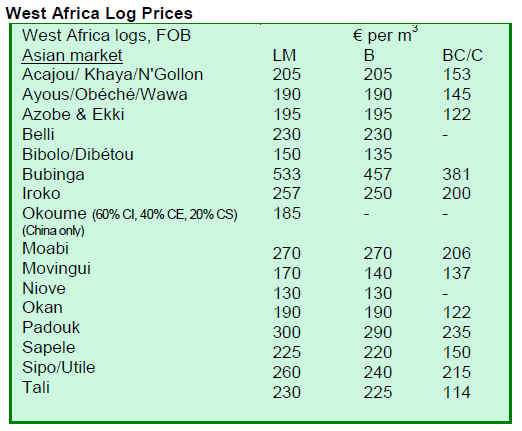
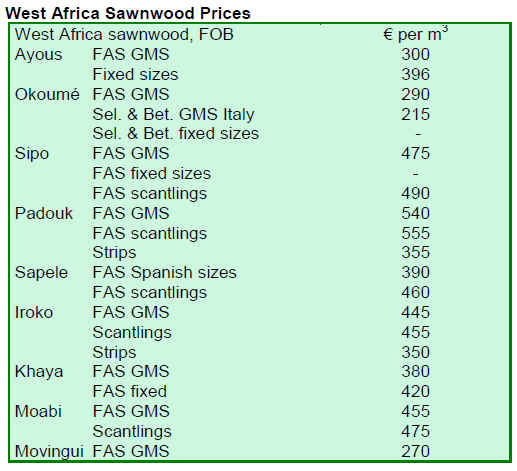
2. GHANA
Ghana Forestry Commission Board sworn in
The new board of the Ghana Forestry Commission has
been sworn in by the Minister of Land and Natural
Resources, Alhaji Collins Duada.
The board members are Yaw Boamah and Urias Armoo
who are the Chairman and Secretary respectively, and Mr.
Attah Nantogmah Alhassan, Osahene Kwakui Aterkyi II,
Mr. Gerald Boakye, Dr. Kwame Asamoa Adam, Mr. Ofori
Frimpong, Dr. Wordworth Odame Larbie, Dr. Mrs. Cecilia
Amoah, Mr. Siisi Crentsil and Mr. Samuel Appiah.
The Minister, in an address, warned that if care was not
taken to halt the current rate of deforestation (estim.
65,000 ha per year), the country¡¯s forest cover would be
depleted in less than 25 years.
The Minister also reportedly stressed that the time had
come for a ¡®siege¡¯ on illegal operators in the forest
reserves. He recommended involving the communities
living on the fringe of the forest to protect the resource.
Bamboo Processing
The dwindling supplies of timber species from Ghana¡¯s
forest reserves is now complemented by plantation timber
and more recently commercialisation of bamboo.
Asante Akim South District Assembly has embarked on a
project for the establishment of a bamboo processing
centre at Obogu near Juaso. This project, a collaboration
between the Assembly and the Rural Enterprises Project
(REP), is to explore the use of bamboo as an alternative to
timber in the production for a variety of products.
A memorandum of understanding was signed between the
two parties and work is underway for the commencement
of the project. Mr. De-graft Forkuo, District Chief
Executive, disclosed this at a district stakeholders
conference for Micro and Small Enterprises (MSEs) at
Juaso.
The conference, which was also used to inaugurate the
assembly's MSE Sub-Committee, discussed the challenges
facing MSEs in the district and sought strategies to move
forward.
Mr. Forkuo noted that the district was among 20 nationwide
to implement such a project and urged all
stakeholders to play an active role towards the reduction of
poverty in the district. The DCE called for collaboration
between the committee and the Business Advisory Centre,
facilitators of the REP, to ensure speedy execution of the
project.
The processing plant is scheduled to begin with the
production of toothpicks and later move into the
manufacture of furniture and other products.

3.
MALAYSIA
Trade promotion the key
The Malaysian minister of international trade and industry
has said that Malaysia will continue to boost its trade
promotional activities to generate growth in the long term.
He added that trade promotional activities were vital and
will eventually generate the desired results in the end
despite of the current global economic slowdown.
He commented that the furniture industry is one of the
industries that is showing signs of recovery with an
improvement in orders. Although prices remain weak, the
Malaysian furniture industry remains competitive and
there are reports of the industry hiring workers again.
ASEAN free trade
The Minister also pointed out that with effect from
January 1, 2010, Malaysia and five other countries in the
Association of Southeast Asian Nations (ASEAN)
grouping ¨C Brunei, Indonesia, the Philippines, Singapore
and Thailand ¨C will be a free trade block that will
eliminate duties on all products within the six countries.
Malaysia has indicated it will eliminate duties on more
than 2,000 items.
China and South Korea are also in the process of deciding
duty eliminations on products within the ASEAN-China
and ASEAN-South Korea Free Trade Agreement. In
addition, the ASEAN-India Free Trade Agreement and the
ASEAN-Australia-New Zealand will come into force at
the same date in 2010.
Market diversification
The chief executive of the Malaysian Timber Council
(MTC) recommended that Malaysian timber companies
producing value-added products should examine
opportunities in the emerging markets of India, Gulf
Cooperation Council countries and S. Asia.
He said that while the global economic crisis has taken its
toll on traditional markets there still viable business
opportunities in the Middle-East where a number of largescaled
construction projects are underway.
Companies which are keen to explore these business
opportunities are encouraged to continue to collaborate
with the MTC by participating in trade shows and
exhibitions organized by the MTC.
Malaysia¡¯s value-added products include mouldings,
builders¡¯ carpentry and joinery and wooden furniture.
The Malaysian timber sector contributes up to 4.5% of the
nation¡¯s gross domestic product annually. West Malaysia
by itself produces more than 5 million cu.m of logs
annually, including rubber wood.
The US and the EU continue to remain two of the main
exports markets for Malaysian timber products. Much now
depends on how quickly the building and construction
sectors in these markets recover.
Sarawak promotion in middle-east
The Sarawak timber sector sustained a 25% drop in the
value of exports in the first half of this year. While
markets in western countries fell badly, it was China, India
and Japan that saved the industry from even greater losses.
Reports indicate that it was the plywood markets that were
the weakest and only imaginative pricing and cost savings
allowed the industry to weather the poor market
conditions.
The local press in Malaysia is reporting that the Sarawak
Timber Industry Development Corporation will send a
delegation to Jeddah, Dubai and Oman to promote
plywood and sawn timber manufactured in Sarawak.
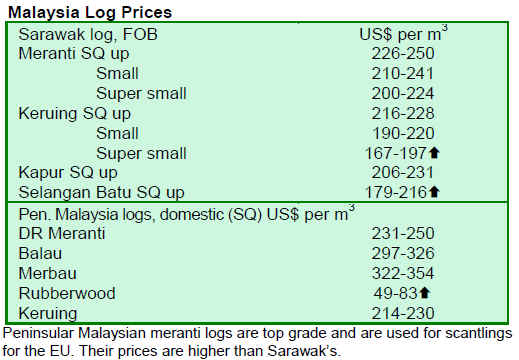
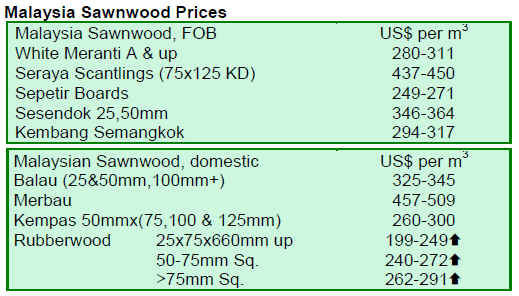
4.
INDONESIA
Slow time for business
The Islamic festival Idul Fitri marking the end of the
Islamic fasting month of Ramadan brought businesses in
Indonesia to a standstill as people in the country returned
to their hometowns. Prices of most commodities, including
timber products are mostly unchanged on a month ago.
Climate change and forestry
The Indonesian forestry ministry is preparing for the 15th.
climate change Conference of Parties (COP) to be held in
Copenhagen, Denmark in December 2009.
Indonesia is reportedly planning to provide two
demonstrations of an application of a mechanism under
the Reduction Emission from Deforestation and
Degradation (REDD) illustrating that Indonesian is
capable of reducing carbon emission by 2.3 giga tons.
One of the demonstrations will be held in Central
Kalimantan, with assistance from Germany and the other
in the Berau district, East Kalimantan province, with the
assistance of the Nature Conservancy (TNC).
One purposes of the demonstration was to show the
potential of the carbon stock in Indonesian forest in order
to determine whether REDD Plus could be applied.
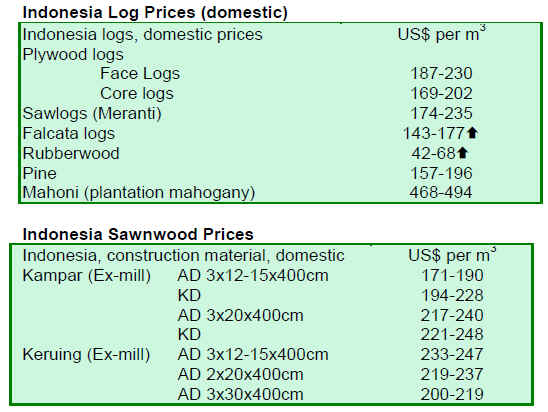
5.
MYANMAR
Teak plantation opportunities
On a recent inspection tour of forest plantations
Myanmar¡¯s Prime Minister highlighted the abundance of
vacant land in the country and how the technical knowhow
developed for establishing teak plantations should be
harnessed to expand the area under plantations.
With this in mind he urged the responsible government
departments and entrepreneurs to plan the expansion of
plantations across the country. The Prime Minister also
visited a private teak plantation established by Phyo Sithu
Co. in Paukkhaung.
At a briefing as part of the inspection by the Prime
Minister, the Forestry Minister reported that just over
830,000 ha. of plantations have been established to date
and of this around half is of teak.
Taking up the call by the prime Minister the Myanma
Ahlin Newspaper ran a special on the benefits from
establishing plantations. In highlighting the financial
returns and environmental benefits the paper took up the
Prime Minister¡¯s call and urged the local entrepreneurs
and local people to consider establishing plantations. This
is particularly urgent as the 2008/9 target of 100,000 ha. of
teak plantations was missed badly with only some 13,000
ha. being established.
In the case of hardwood plantations, some 20,000 ha. were
established last year but this was only around 50% of the
target. The local press in Myanmar has reported on efforts
for so-called ¡®greening¡¯ in townships in Yangon, Bago,
Mandalay and Magway which has been underway since
2004. A 250 ha. plantation in Ottwin township was started
in 2007-08 and already the seedlings are just over 1 m in
height.
Market situation in Myanmar continues to be slow
The market is reported to be generally unchanged from the
past month. Buying and selling is active as fresh logs
arrive from the forests. At present the Indian sawnwood
and log market is reported as quite firm.
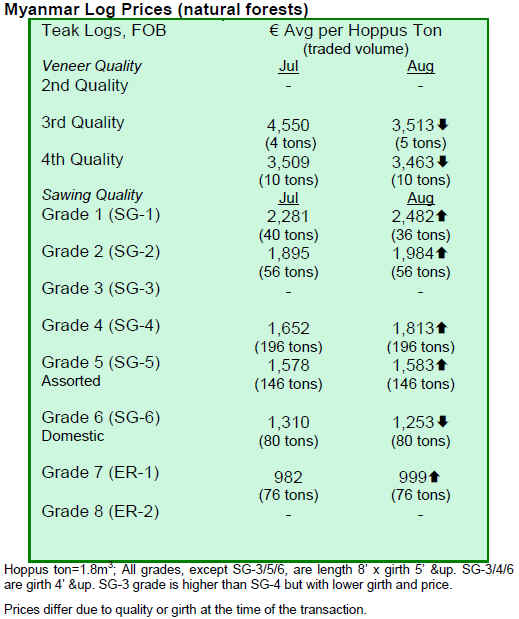
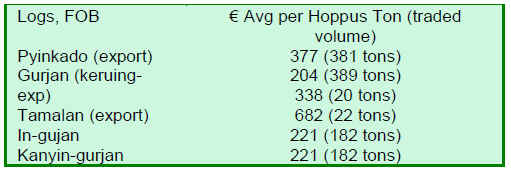
6. INDIA
Impact of free trade
India¡¯s Free Trade Agreements are impacting domestic
wood products manufacturers, especially the wood based
panel makers.
Domestic MDF and high density fibreboard, hardboard
and particleboard produced in India face stiff price
competition from imports. They found it hard to make
savings because of the relatively high cost of raw materials
in India.
Many panel product factory development plans have been
postponed or shelved. Some investors are considering relocating
production or acquiring plant in countries such as
Thailand, Malaysia or Indonesia where raw material
availability is better.
Reports say that Archidply, a major producers of panel
products with laminated particleboard and decorative
plywood plant at Chintamani in Karnataka, has decided to
delay the second phase expansion scheduled for 2009-
2010.
The company had reportedly planned expanding
particleboard production at Chintamani and a new MDF
factory at Rudrapur Uttarakhand.
In view of the severe weakness in the international
markets, panel product import prices have come down
drastically thus making domestic expansion of capacity
risky.
Domestic investment in panel production
Despite the global economic slow down India has been
maintaining 6% plus growth and there has been domestic
investment in finger jointing plant and some panel
products. These factories utilise wood waste and
agricultural residues such as cottonseed shells, ground nut
and soya bean shells and bagasse. Some is also converted
into briquettes, the use of which reduces dependence on
solid fuelwood from the forest.
Eurowood Lumber Pvt Ltd has plant at Bhachau in Kutch
district of Gujarat for fully automated UV coated solid
wooden flooring. They are also making finger jointed
flooring, being the first in India to produce very large
boards. The new facility includes a bio-briquette plant.
Hardwood imports
India¡¯s imports of tropical hardwoods have picked up as
the south west monsoon is coming to a close.
Domestic demand for timber is also strengthening and the
balance in consumption between imports and local
production is being maintained. Exports of wood based
products are also stable.
Imports of Teak from Sudan have been somewhat slow
recently but the slack has been taken up by supplies from a
new entrant to the Indian market, Guatemala.
The industry is saying that the quality being received from
Guatemala is good and well suited to the Indian market.
Future driver of growth
Expanded Infrastructure works are set to accelerate India's
economic growth over the next 10 years according to
reports attributed to India¡¯s Road Transport and Highways
Minister.
As an example, the Minister mentioned the Delhi-Mumbai
Industrial Corridor, a US$90 billion infrastructure project.
This will be undertaken in cooperation with Japan and will
involve the development of industrial clusters and rail,
road, port and air facilities.
The major challenge for this project is not finance, it is
said to be land acquisition and the capacity of the
developers to manage the various projects.
Such infrastructure development projects stimulate
demand for wood products notably plywood and other
woodbased panels as well as sawnwood.
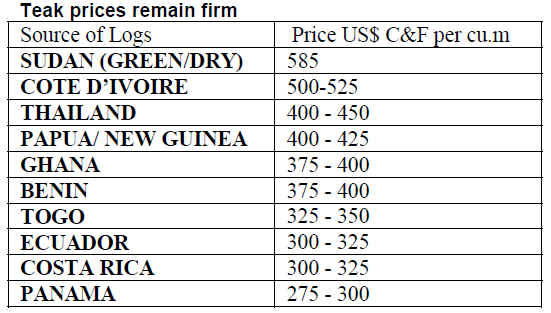
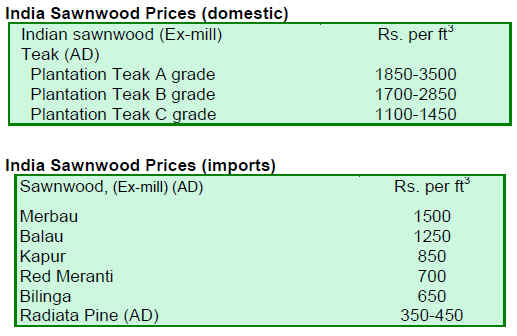
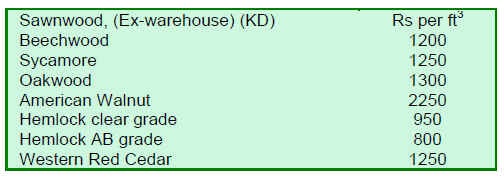
7. BRAZIL
Brazil needs investment in added value
Wood flooring production is one of the main value added
products in Brazil. In 2007, the country produced about 34
million sq.m of wood flooring and exports exceeded US$
600 million.
Over the past 10 years flooring production has doubled but
is still only about a tenth of that of China and a quarter of
that of the USA and Europe.
In addition to flooring, the furniture industry traded
R$14billion in 2007 of which R$ 1.1 billion was exported.
Exports of other added value products including moldings,
doors, flooring and other manufactured products earned
some US$ 2.2 billion in 2007.
Against this background Brazil¡¯s Associação Nacional dos
Produtores de Pisos de Madeira (ANPM) has recently
called for the country to have a more progressive
industrial policy for the forestry sector.
ANPM reportedly called for authorities to appreciate that
it is through value creation from the forest to final product
that can ensure sustainable utilisation, adoption of good
management plans and legal sourcing of raw materials.
ANPM said that the forest-based production chain in
Brazil engages about 6.5 million people (9% of the
country¡¯s economically active population), of which 2.5
million are in the solid wood sector. Out of these, about
215,000 work directly in the timber processing activities,
equivalent to 4.3% of total jobs.
Moreover, many Brazilian forest sector companies
promote interaction with local communities through
partnership projects. As an example the ¡°Good
Management Project¡± was quoted. This is directed and
coordinated by the Brazilian Agricultural Research
Corporation (Embrapa) with the participation of timber
companies. Its objective is to develop and disseminate
good forest management practices to be adopted by both
companies and local communities.
Exports from Par¨¢ fall
The market for tropical timbers remains weak and this is
seriously impacting companies in the Amazonian state of
Par¨¢ where most of logging of natural forests takes place
in Brazil.
Timber exports were US$73 million in the first six months
of 2009 down 52% compared to the same period in 2008.
Entrepreneurs expect improvements in the coming months.
According to the Timber Exporter Association of Par¨¢
(AIMEX), there were months where exports were down as
much as 65% so the performance in the latest quarter was
something of an improvement.
AIMEX¡¯s optimism was backed up by 2% increase in
timber export from May to June. However, production by
mills from January-June dropped 34% compared to the
same period of 2008. Nevertheless, if June data is ignored
there was only a 29% fall according to the Brazilian
Institute of Geography and Statistics (IBGE).
In Par¨¢, timber is one of the main drivers of the state¡¯s
economy, accounting for about 5% of Gross Domestic
Product (GDP).
In 2007, the timber industry traded approximately R$ 3.5
billion, producing 9 million cu.m of logs and this
generated revenues of R$ 1 billion, equivalent to 77% of
Brazil¡¯s Northern Region production according g to IBGE.
Exports remain weak
In August 2009, exports of wood products (excluding pulp
and paper) fell 39% (from US$ 292.5 million to US$
178.7 million) compared to August 2008.
The value of pine sawnwood exports dropped 55% in
August 2009 compared to the same month of 2008, while
in volume terms the decline was recorded as 48%.
Exports of tropical sawnwood have also fallen
significantly both in volume and in value, from 69,800
cu.m in August 2008 to 48,400 cu.m in August 2009
(down 37%) and from US$ 34 million to US$ 21 million,
respectively, (down 31%) over the same period.
Pine plywood exports fell sharply in August (down 47% in
value) compared to the same period of 2008. In terms of
volume the decline was 31% over the period, from
109,300 cu.m to 76,000 cu.m.
Exports of tropical plywood have dropped dramatically
from 18,200 cu.m in August 2008 to only 8,800 cu.m in
August 2009 representing a fall of 52%. In value terms the
fall was even more pronounced (57%)
Exports of wooden furniture fell from US$ 66 million in
August 2008 to US$ 48 million in August 2009,
representing a 28% drop over the period.
The government of the Northern Amazonian state of Acre
is willing to spend R$ 478 million over the next 15 years
to pay local people to conserve or restore the natural
forest. Indians and ranchers/farmers will be compensated
if they can prevent deforestation.
The government plan does not focus only on conservation.
Land users who can raise productivity without expanding
the area occupied will also be compensated.
According to the Acre Secretary of the Environment, the
plan will be implemented in 2010. The first areas to
benefit will be the areas most susceptible to deforestation
such as those along the BR-364 highway, which cuts
through the entire state.
The state government is still discussing the funding
sources for payment, one option being considered is
generating carbon credits through the REDD (Reducing
Emissions from Deforestation and Degradation)
mechanism.
Shut down illegal sawmills
The Brazilian media recently reported on the 'Arco de
Fogo' Operation, an effort to fight illegal activities on the
indigenous lands of Alto Turiaçu, Awa-Guaj¨¢ and Car¨²
and on the Biological Reserve of Gurupi in the Brazilian
Amazon.
Recently a total of 33 illegally operating sawmills were
shut down and more than 3,000 cu.m of timber were
seized.
According to the Ministry of the Environment, besides
these proactive operations, there is a need to increase
sustainable income alternatives for the forest dependent
population. The challenge is not only to seize timber but
also to give these people the opportunity to live with
dignity.
Maranhão in the Amazon is one of the "hot spots" for
deforestation in the state and has suffered severe
deforestation according to the Ministry. This is one region
where the ¡°Arco de Fogo¡± operation is conducted.
Economic news
Brazil¡¯s Consumer Price Index (IPCA) for August 2009
increased slightly and the accumulated rate January to
August is 2.97% below the rate for the same period in
2008. Over the past twelve months the rate remained at
4.36%, slightly below the previous twelve months period.
In August 2009, the average exchange rate was BRL
1.84/US$, compared to BRL 1.61 in August 2008 which
illustrates the depreciation of the Brazilian currency over
the US currency over 12 months.
The Monetary Policy Committee (Copom) maintained the
prime interest rate (Selic) at 8.75%. This decision ends the
recent cycle of monetary policy flexibility with
progressive rate cuts. Since January, the interest rate has
fallen 5%.
The Copom estimates that the present rate is consistent
with maintaining inflation within the target and for the
non-inflationary recovery of economic activity. The
Central Bank is satisfied with the current Selic rate level,
which is allowing the strengthening of economic activity
without creating inflationary risks.
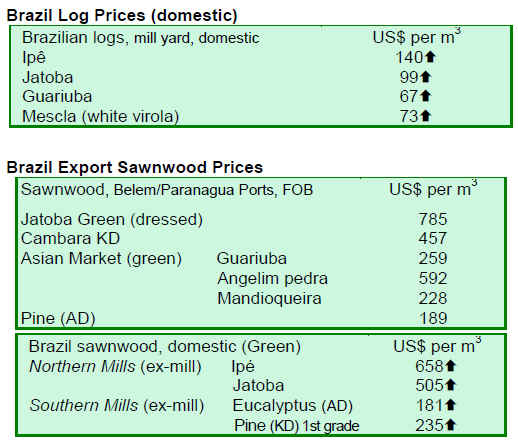
8.
PERU
Facing the competition
Producers of wooden building materials are re-assessing
prices for roof timbers for the state construction projects
such as the Mivivienda.
This is being done to try and stimulate the local timber
roof sector in the face of strong competition from imported
wood building products especially those from Chile. The
National Forest Chamber says it feels that the State¡¯s
decision on procurement is solely on price and should look
at local materials which, it says, are of better quality.
The head of the National Forest Chamber said that
Peruvian wood products are superior to those imported
and this is why prices are higher but to secure a market,
local producers will re-negotiate price structures.
Grant for forestry sector
The government of Peru manages a grant of US$126 mil.
from the government of Japan to finance two programmes,
one is on processing of solid wood residues and the other
on forest conservation.
This grant will be through the Japanese Agency of
International Cooperation (JICA). The conservation effort
will be in the Amazon and on the north coast. The purpose
is to preserve Peru¡¯s primary Amazonian forests.
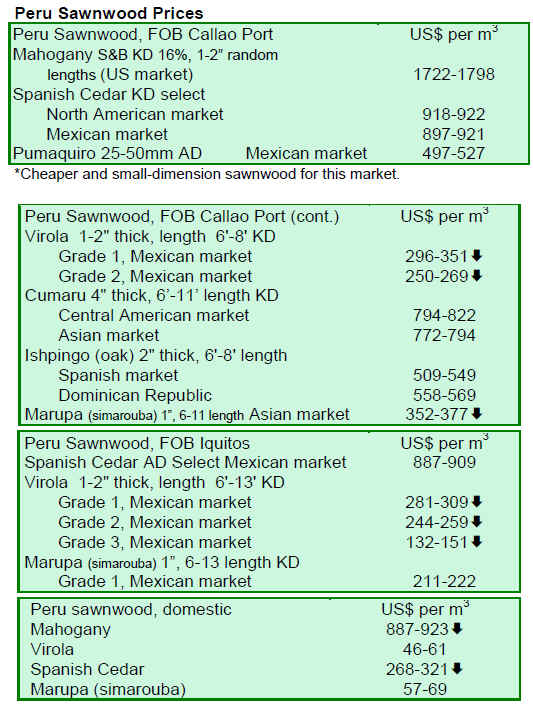
9. BOLIVIA
Certified exports plummet
In 2008 exports of certified wood products (approx.
US$18 million) represented just under 10% of total
exports, a major decline of 51% compared to the previous
year.
More than 80% of certified wood products are added
value items for markets in North America, Europe, Asia
and Latin America.
The number of certified products exported has grown
rapidly from 4 products exported in 1998 to around 20
products exported in recent years.
These include furniture and furniture parts, decking,
parquet, sawn timber, doors and frames and moldings.
Sawn timber is no longer the most important certified
products exported today.
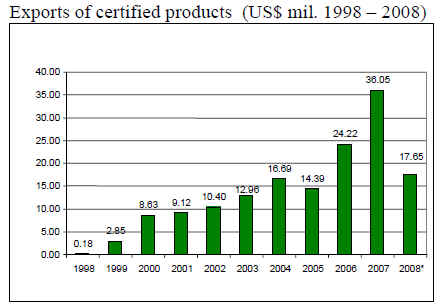
Voluntary forest certification has helped Bolivia towards
sustainable forest management and conservation of its
tropical forests. Despite this progress more work is
required to market certified wood products. There are
many challenges at home also; the area certified represents
only 23% of the total area under forest management and
small producers face a major challenge in becoming
certified because of the cost involved.

10. MEXICO
Expo Forestal underway
Mexico¡¯s Expo Forestal 2009 is underway and is the one
of the main forestry and wood product shows in Mexico.
Its mission is to gather in one place the forestry sector of
the country as well as international experts.
Expo Forestal exhibitors include forestry service
providers, stock maintenance and forestry area
management, cartography, forestry tools, timber
harvesting techniques, timber transport systems, logistics
solutions, soil care and maintenance, pest control.
http://www.biztradeshows.com/trade-events/expoforestal.
html
New head for Conafor
Dr. Juan Manuel Torres Rojo has been appointed as the
head of the National Forestry Agency (Conafor). Dr.
Torres Rojo has served as a research professor at the
Research and Economic Teaching Center. In addition, he
has been a visiting professor at the University of
California at Berkeley, and associate professor at the
University of the Americas in the state of Puebla.
During the 1990s he was adviser and director of the
National Reforestation Program of the Ministry of
Agriculture and Water Resources. He is the author of
several publications on forest resource management,
agricultural policy and sustainability.
On many occasions the National Forest Agency has
insisted that the main problem it saw was the destruction
of the country's natural ecosystems. The long-term
conservation of forest ecosystems and the use of its full
potential will depend, among other things, on the
implementation of a set of competitive and viable socially,
environmentally and economically economic instruments.
That is why the appointment of the new director of
Conafor, a specialist in natural resource economics and
researcher at CIDE, is very encouraging as it may result in
the strengthen forest policy in Mexico with a renewed
vision and a different perspective.
11.
Guyana
Market Trends
Since the last report prices have firmed for Purpleheart
logs with standard sawmill quality and fair sawmill quality
having recorded higher prices.
Also, prices for sawnwood have increased. For rough
sawn Greenheart, prime and select prices have risen to
US$ 848/700 per cu.m.
Purpleheart rough sawn prices have also strengthened for
both sound and merchantable qualities; on the other hand
Mora prices remain unchanged. Dressed Purpleheart prices
also increased compared to 2 weeks ago.
Greenheart roundwood prices improved marginally in the
period under review while Splitwood prices fell. Plywood
prices remained fairly stable for this period.
Trade in value added products
The trade in value added products was good in the period
1st ¨C 15th Sept. 2009. Doors and windows, followed by
indoor and outdoor furniture were major contributors to
the value added export earnings.
Other products of note were door frames, mouldings,
spindles and wooden utensils. The Caribbean remains the
leading export market for these products.
Low Carbon Development Strategies
Guyana has been employing Low Carbon Development
Strategies (LCDS) in a number of projects. One of these is
the Chain Sawmilling Project the theme of which is:
¡°Towards sustainable chainsaw milling in Ghana and
Guyana¡±.
In addressing the issue of chainsaw milling in Guyana, the
evidence gathered suggests that two general lines of
actions (and their interactions) need be considered:
strategic interventions and improvement of current
practices.
The purpose of the chainsaw milling project, launched in
2007, was to effect strategic intervention and improvement
of current practices. A related publication issued by the
project states that ¡°strategic interventions must start from a
vision on the future of the chainsaw lumbering sub-sector
in relation to the regular forest sector, the role of forestry
in the development of the nation and the hinterland
communities as well as potentially competing land uses
including allocation of lands to carbon sequestration¡±.
Improvement of current chainsaw milling practices in
small hinterland communities involves capacity building
and empowerment that leads to informed decision making
on the implementation of regulations and guidelines, the
promotion of viable livelihood changes in the forest, and
the conservation and sustainable management of Guyana¡¯s
tropical forest. The Low Carbon development Strategy
provides excellent opportunities to put these
considerations into a wider framework.
A four day monitoring and evaluation workshop on this
project conducted on 21-24th September, 2009 made
mention of the compatibility of the chainsaw milling
project and the LCDS.
Milestones for the project, such as the development of
alternative livelihood options in the forest and improved
capacity building and empowerment in communities, were
brought out by community forestry workers involved in
the project.
These are being accomplished by identifying the needs of
the community. Training courses in forestry related skills
and techniques are currently conducted by the Forestry
Training Centre in respective pilot communities.
This Chainsaw milling initiative stems from the fact that in
many local and indigenous forest dependent communities
it is an important component of livelihood support and for
practical survival.
Some of the actions of the project are focused on the broad
theme of forest governance in the country and in Ghana
and Guyana chainsaw milling is common and the aim is to
foster positive sustainable forestry practices.
The chainsaw milling project is EU funded and much of
the implementation is carried out by Tropenbos
International in collaboration with Forestry Research
Institute of Ghana (FORIG) and the Forestry Commission
in Ghana with the Forestry Training Center Inc. (FTCI)
and Iwokrama in Guyana.
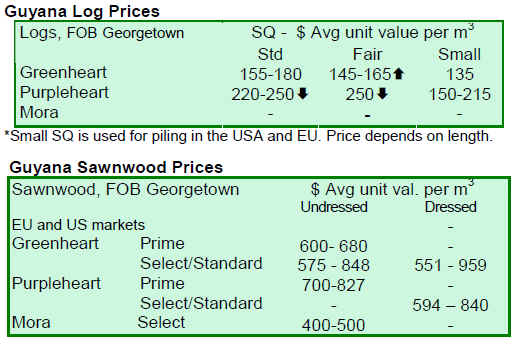
|